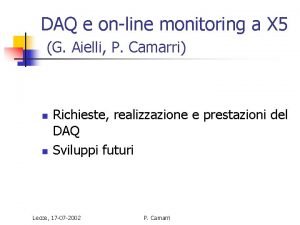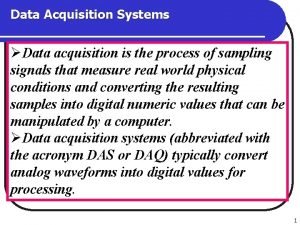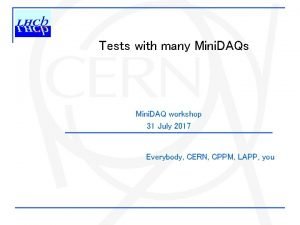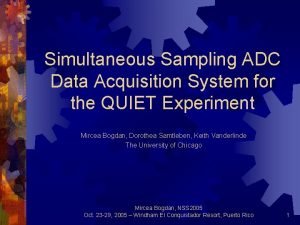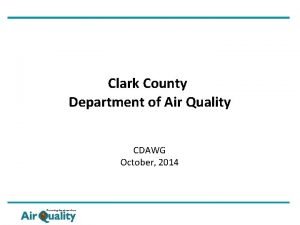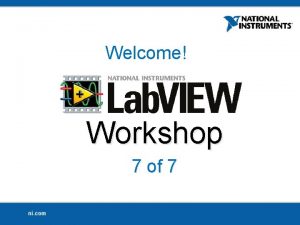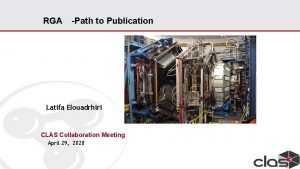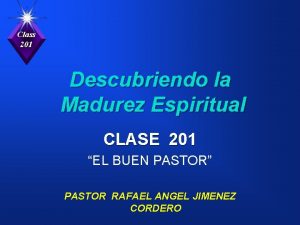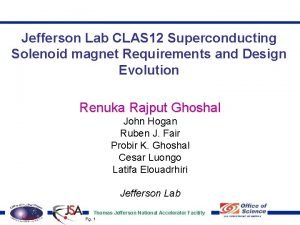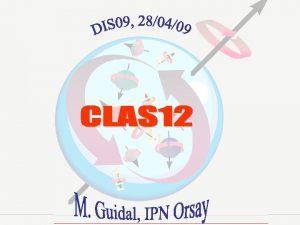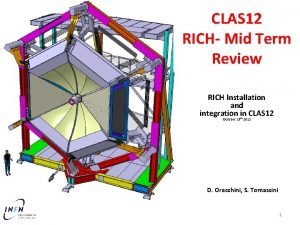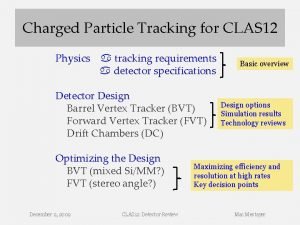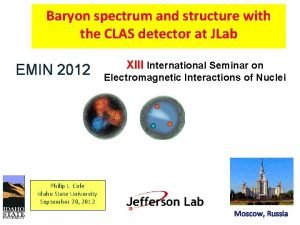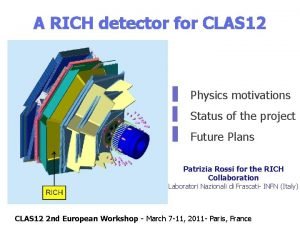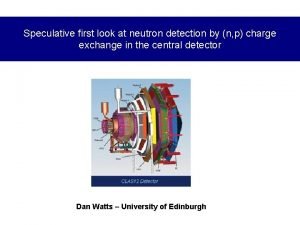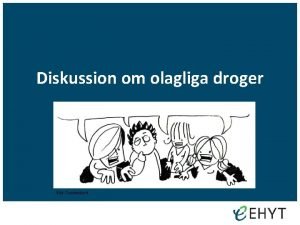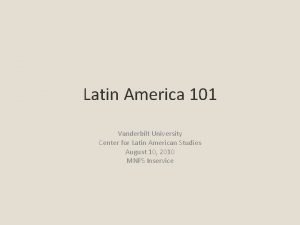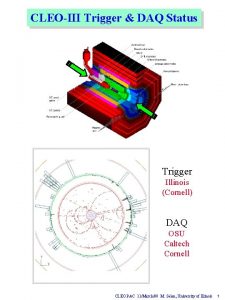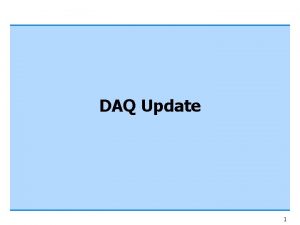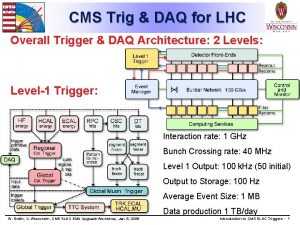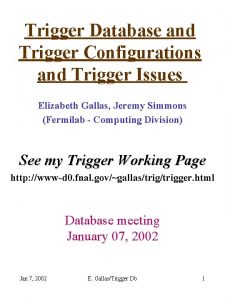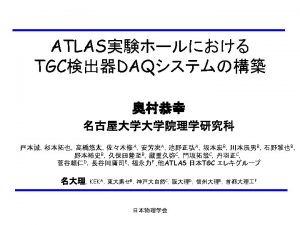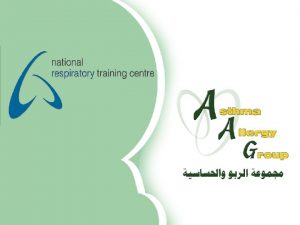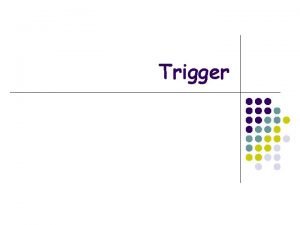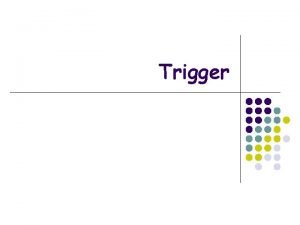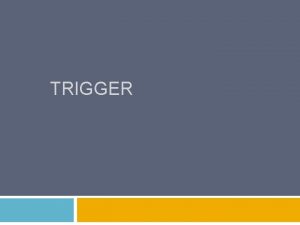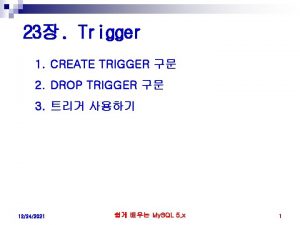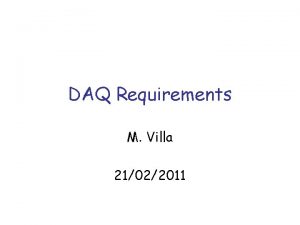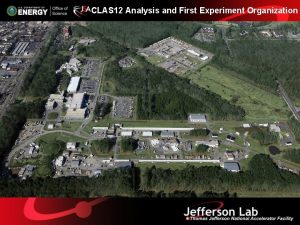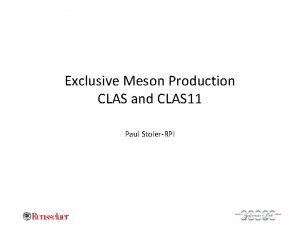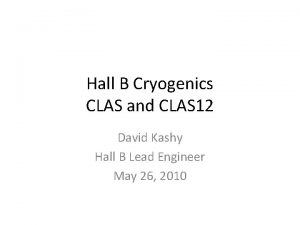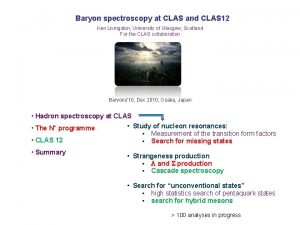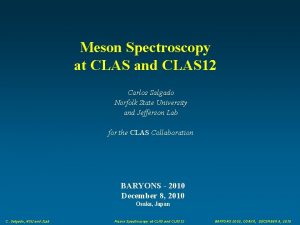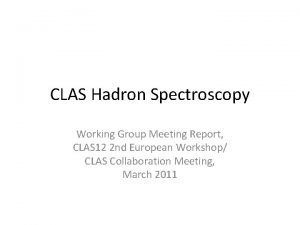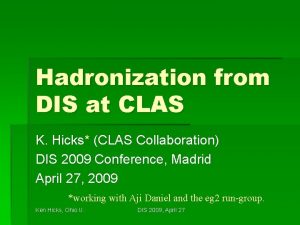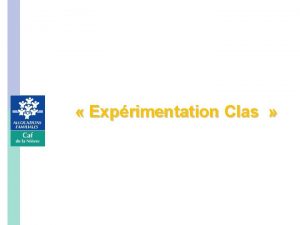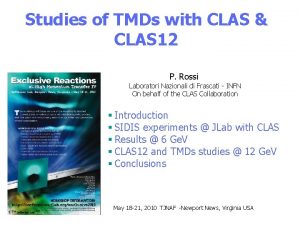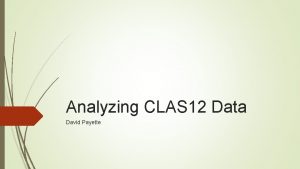CLAS 12 DAQ Trigger and Online Computing Requirements




























- Slides: 28

CLAS 12 DAQ, Trigger and Online Computing Requirements Sergey Boyarinov Sep 25, 2017

Notation • • • • • ECAL – old EC (electromagnetic calorimeter) PCAL – preshower calorimeter DC – drift chamber HTCC – high threshold cherenkov counter FT – forward tagger TOF – time-of-flight counters MM – micromega tracker SVT – silicon vertex tracker VTP – VXS trigger processor (used on trigger stage 1 and stage 3) SSP – subsystem processor (used on trigger stage 2) FADC – flash analog-to-digital converter FPGA – field-programmable gate array VHDL – VHSIC Hardware Description Language (used to program FPGA) Xilinx – FPGA manufacturer Vivado_HLS – Xilinx High Level Synthesis (translates C++ to VHDL) Vivado – Xilinx Design Suite (translates VHDL to binary image) GEMC – CLAS 12 GEANT 4 -based Simulation Package CLARA – CLAS 12 Reconstruction and Analysis Framework DAQ – Data Acquisition System 2

CLAS 12 DAQ Status • • • Online computer cluster is 100% complete and operational Networking is 100% complete and operational DAQ software is operational, reliability is acceptable Performance observed (KPP): 5 k. Hz, 200 MByte/sec, 93% livetime (livetime is defined by hold-off timer = 15 microsec) Performance expected: 10 k. Hz, 400 MBytes/sec, >90% livetime Performance limitation expected: 50 k. Hz, 800 MBytes/sec, >90% livetime (based on Hall. D DAQ performance) Electronics installed (and was used for KPP): ECAL, PCAL, FTOF, LTCC, DC, HTCC, CTOF, SVT TO DO: Electronics installed recently or will be installed: FT, FTMM, CND, MM, scalers, helicity TO DO: CAEN v 1290/v 1190 boards (re)calibration TO DO: Full DAQ performance test 3

DAQ/Trigger Hardware Layout 24 1 1 3 1 19 18 3 INSTALLED: 66 crates, 88 readout controllers 4

Runcontrol: setting DAQ/Trigger parameters

CLAS 12 DAQ Commissioning • • Before beam performance test: running from random pulser trigger with low channel thresholds – measure event rate, data rate and livetime Cosmic data: running from electron trigger (ECAL+PCAL and ECAL+PCAL+DC) – obtain data for offline analysis to check data integrity and monitoring tools Performance test using beam: running from electron trigger – measure event rate, data rate and livetime with different beam conditions and DAQ/Trigger settings Timeline: before beam tests – one month (November); beam test - one shift; we assume that most of problems will be discovered and fixed before beam test 6

CLAS 12 Trigger Status • • • All available trigger electronics installed. It includes 25 VTP boards (stage 1 and 3 of trigger system) in ECAL, PCAL, HTCC, FT, R 3 for all sectors and R 1/R 2 for sector 5 in Drift Chamber and main trigger crates, 9 SSP boards in stage 2 20 move VTP boards arrived and being installed in remaining DC crates and TOF crates, should be ready by October 1 All C++ trigger algorithms completed including ECAL, PCAL, DC and HTCC, FT modeling to be done FPGA implementation completed for ECAL, PCAL and DC, HTCC and FT is in progress ‘pixel’ trigger is implemented in ECAL and PCAL for cosmic calibration purposes Validation procedures under development 7

CLAS 12 Trigger System Layout VTP for FT (3) 8

PCAL+DC trigger event example 9

CLAS 12 Trigger Components Summary stage name Clock (ns) algorithm input Output to trigger Output to datastream Control registers 1 ECAL 32 Cluster finding with energy correction FADC 4 clusters List of clusters Thresholds, windows 1 PCAL 32 Cluster finding with energy correction FADC 4 clusters List of clusters Thresholds, windows 1 DC 32 Segment finding DCRB Segment mask Thresholds, windows 1 HTCC 4 Cluster finding FADC Cluster mask Thresholds, windows 1 FT 4 Cluster finding FADC Cluster mask Thresholds, windows 2 sector 4 Stage 1 components coincidence, DC road finding stage 1 Component mask Coincidence logic, windows 3 global 4 Stage 2 components coincidence stage 2 16 -bit trigger Component mask Coincidence logic, windows NOTE: FTOF, CTOF and CND can be added to trigger stage 1 10

CLAS 12 Triggers # Notation Reaction 1 R 1 Pulser Random / regular DAQ 2 Random Tr. Faraday cup Background 3 E 1 ep->e’X e’(CLAS) PCAL*Ectot*(DCtrack) Test HTCC efficiency 4 E 2 ep->e’X e’(CLAS) HTCC*E 1 Inclusive electron trigger 5 FT ep->e’X e’(FT) FTcluster(Emin, Emax) FT only, prescaled 6 FTHODO ep->e’X e’(FT) FT*HODO 1*HODO 2 FT and HODO 1, 2, prescaled 7 H 1 ep->e’h+X 1 hadron FTOF 1 a*FTOF 2*PCAL(DCt rack) One hadron, prescaled 8 H 2 ep->e’ 2 h+X 2 hadrons FTOF 1 a*FTOF 2*PCAL(DCt rack) Two hadrons, prescaled 9 H 3 ep->e’ 3 h+X 3 hadrons FTOF 1 a*FTOF 2*PCAL(DCt rack) Three hadrons, prescaled 10 mu 2 ep->e’p+m+ m- FTOF 1 a*FTOF 2*[PCAL+E Ctot]* (DCtrack) m+ m- +hadron 11 FT 1 ep->e’+h e’(FT)+h+X FThodo*H 1 FT+ 1 hadron, prescaled 12 FT 2 ep->e’+2 h e’(FT)+2 h+X FThodo*H 2 FT+ 2 hadrons, prescaled 13 FT 3 ep->e’+3 h e’(FT)+3 h+X FThodo*H 3 FT+3 hadrons - Final State Trigger

Trigger Configuration file VTP_CRATE adcecal 1 vtp # trigger stage 1 VTP_ECINNER_HIT_EMIN 100 # strip energy threshold for 1 -dim peak search VTP_ECINNER_HIT_DT 8 # +-8 clk = +-32 ns: strip coincidence window to form 1 -dim peaks, # and peak-coincidence window to form 2 -dim clusters VTP_ECINNER_HIT_DALITZ 568 584 # x 8: 71<dalitz<73 ……………. . SSP_CRATE trig 2 # trigger stage 2 SSP_SLOT all SSP_GT_STRG_ECALIN_CLUSTER_EMIN_EN 0 1 # enable ECAL_INNER clusters in trigger SSP_GT_STRG_ECALIN_CLUSTER_EMIN 0 2000 # ECAL_INNER cluster threshold SSP_GT_STRG_ECALIN_CLUSTER_WIDTH 0 100 # coincidence window to coincide with PCAL etc ………………. . VTP_CRATE trig 2 vtp # trigger stage 3 # slot: 10 13 09 14 08 15 07 16 06 17 05 18 04 19 03 20 # payload: 01 02 03 04 05 06 07 08 09 10 11 12 13 14 15 16 VTP_PAYLOAD_EN 0 0 1 0 1 0 1 0 # 6780 corresponds to 7900 FADC latency VTP_GT_LATENCY 6780 # sector bits: trig number, ssp trig mask, ssp sector mask, multiplicity, # coincidence=number_of_extended_clock_cycles VTP_GT_TRGBIT 8 1 1 ……………… There is a plan to provide GUI to handle configuration files 12

CLAS 12 Trigger Validation • All stage 1 trigger algorithms ether implemented in C++ (ECAL, PCAL, HTCC) or have C++ emulation of the hardware implementation (FT – to do) • Higher stages will be emulated – under discussion, likely the same way as stage 1 • Validation process has 2 steps: 1. Comparison between C++ implementation and hardware response 2. Comparison between C++ implementation and GEANT and reconstruction results 13

FPGA Image Building Chain and Validation Step 1: Comparison between C++ implementation and hardware response (cosmic and beam) Xilinx Vivado_hls . VHDL Trigger C++ Step 1 Validation Xilinx Vivado. bin (FPGA image) DAQ. evio 14

Xilinx Vivado_HLS (C++ to VHDL) 15

Xilinx Vivado (VHDL to FPGA image) 16

Validation Step 1: Comparison between C++ implementation and hardware response /work/boiarino/data/vtp 1_001212. evio. 0 event 3: FPGA implementation data bank ============= TRIG PEAK [0][0]: coord=298 energy=1610 time=7 TRIG PEAK [1][0]: coord=174 energy=1012 time=7 TRIG PEAK [1][1]: coord=174 energy=294 time=8 TRIG PEAK [2][0]: coord=447 energy=1226 time=7 TRIG HIT [0]: coord=298 174 447 energy=4936 time=7 C++ implementation using FADC data =========== U: IT=7 peak. U[0]: coord=298 energy=1610 V: IT=7 peak. V[0]: coord=174 energy=1012 W: IT=7 peak. W[0]: coord=447 energy=1226 SOFT HIT: coord=298 174 447 energy=4936 17

Validation Step 2: Comparison between C++ implementation and GEANT/CLARA GEMC Or Trigger C++ DAQ (. evio) CLARA Offline Reconstruction NOTE: that step allows Offline Reconstruction team to get ready for trigger results processing during beam time 18

C++ trigger on GEANT data – ECAL event example 19

Validation Step 2: Comparison between C++ implementation and GEANT/CLARA (cont. ) ECAL cluster finding: difference trigger-offline 20

Validation Step 2: Comparison between C++ implementation and GEANT/CLARA (cont. ) ECAL cluster finding: 5 Ge. V electron, no PCAL, energy deposition, offline and C++ Trigger Sampling fraction 27% 21

CLAS 12 Trigger Commissioning • • Validation step 1 (cosmic): running from electron trigger (ECAL+PCAL and ECAL+PCAL+DC) and comparing hardware trigger results with C++ trigger results Validation step 2 (GEANT): processing GEANT data (currently contains ECAL and PCAL, will add HTCC and others) through C++ trigger and producing trigger banks for following offline reconstruction analysis Validation step 1(beam): running from electron trigger (ECAL+PCAL, ECAL+PCAL+DC, ECAL+PCAL+HTCC) and comparing hardware trigger results with C++ trigger results Taking beam data with random pulser – for trigger efficiency studies in offline reconstruction Taking beam data with electron trigger (ECAL+PCAL [+HTCC] [+DC]) with different trigger settings – for trigger efficiency studies in offline reconstruction Taking beam data with FT trigger - for trigger efficiency studies in offline reconstruction Timeline: cosmic and GEANT tests – underway until beam time; beam validation – 1 shift, after that data taking for detector and physics groups 22

Online Computing Status • • Computing hardware is available for most online tasks (runtime databases, messaging system, communication with EPICS etc) There is no designated ‘online farm’ for data processing in real time, two hot-swap DAQ servers can be used as temporary solution; considering part of jlab farm as designated online farm for CLAS 12 Available software (some work still needed): process monitoring and control, CLAS event display, data collection from different sources (DAQ, EPICS, scalers etc) and data recording into data stream, hardware monitoring tools, data monitoring tools Online system will be commissioned together with DAQ and Trigger systems, no special time is planned 23

Online Computing Layout About 110 nodes

CLAS 12 Data Flow (online farm proposed) Computer Center ROCs (~110) E B Data monitoring (2 servers) ET ER 40 Gb Disk 40 Gb Data Monitoring Results Counting House Disk/Tape Farm 40 Gb Online Farm

RCDB (Runtime Condition Database) - operational 26

Messaging - operational • Old Smartsockets was replaced with Active. MQ • Active. MQ is installed on clon machines and tested on all platforms where it suppose to be used (including DAQ and trigger boards) • Critical components were converted to Active. MQ, more work to be done to complete, mostly on EPICS side • Messaging protocol was developed, allows to use different messaging if necessary (in particular ‘x. Msg’ from CODA group) 27

Conclusion • • CLAS 12 DAQ, computing and network was tested during KPP run and worked as expected, reliability meets CLAS 12 requirements, performance looks good but final tests have to be done with full CLAS 12 configuration (waiting for remaining detectors electronics and complete trigger system) Trigger system (included ECAL and PCAL) worked as expected during KPP. Other trigger components (DC, HTCC and FT) were added after KPP and being tested with cosmic; remaining hardware has been received and being installed Online software development still in progress, but available tools allows to run Timeline: few weeks before beam full system will be commissioned by taking cosmic data and running from random pulser; planning 2 shifts for beam commissioning 28
 Daq online
Daq online Data acquisition system block diagram
Data acquisition system block diagram Mini daq
Mini daq Bls game
Bls game Simultaneous sampling daq
Simultaneous sampling daq Clark county daq
Clark county daq Daq assistant express vi
Daq assistant express vi Conventional computing and intelligent computing
Conventional computing and intelligent computing Uf clas advisors
Uf clas advisors O pernuta afanata
O pernuta afanata Clas collaboration meeting
Clas collaboration meeting Clas standards 5-8
Clas standards 5-8 Clas rehnberg
Clas rehnberg Beneficios de la madurez espiritual
Beneficios de la madurez espiritual Clas do jo
Clas do jo Good morning. welcome to class.
Good morning. welcome to class. Clas nord
Clas nord Clas12
Clas12 Clas
Clas Diagram kelas adalah
Diagram kelas adalah Clas collaboration meeting
Clas collaboration meeting Clas
Clas Clas
Clas Clas
Clas Clas
Clas Clas inserm
Clas inserm Clas rehnberg
Clas rehnberg Lish3
Lish3 Clas vanderbilt
Clas vanderbilt
